-
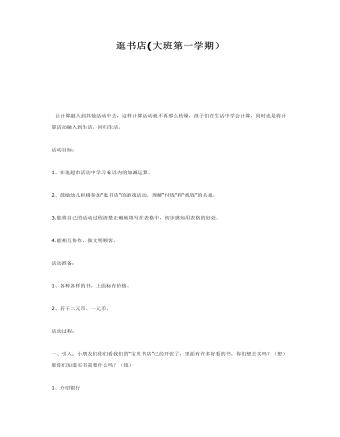
大班数学教案:逛书店
1、在逛超市活动中学习6以内的加减运算。2、鼓励幼儿积极参加“逛书店”的游戏活动,理解“付钱”和“找钱”的关系。3.能将自己的活动过程清楚正确地填写在表格中,初步感知用表格的好处。4.能相互协作,做文明顾客。活动准备:1、各种各样的书,上面标有价格。2、若干二元币、一元币。

大班数学教案:编译密码
2.锻炼幼儿运用逆向思维的方式进行运算,培养幼儿的运算兴趣;3.让幼儿充分感受成功解决数学问题的乐趣。 活动准备教师准备:电话号码卡两张;l一10的数字卡;幼儿准备:熟悉自己家的电话号码;电话号码册、铅笔、橡皮等。 活动组织:1.导入活动师:昨天晚上,我接到从我们班转学的豪豪小朋友打来的电话,他说很想你们,那你们想不想他?如果想他,怎样和他联系?(让幼儿自由讨论,引出打电话的想法。)师:他家的电话号码是xxxxxxxx,(出示电话号码)我们来数数他家的电话号码是几位?(幼儿一起点数)他家电话号码的第几位数是几?
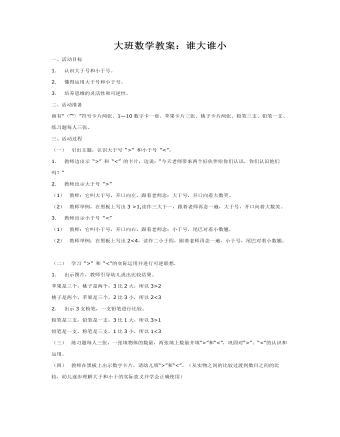
大班数学教案:谁大谁小
二、活动准备 画有“〈”“〉”符号卡片两张、1—10数字卡一套、苹果卡片三张、桃子卡片两张、粉笔三支、铅笔一支、练习题每人三张。 三、活动过程 (一) 引出主题,认识大于号 “>” 和小于号 “<”。 1. 教师边出示 “>” 和 “<” 的卡片,边说:“今天老师带来两个好伙伴给你们认识,你们认识他们吗?” 2. 教师出示大于号 “>” (1) 教师:它叫大于号,开口向左,跟着老师念:大于号,开口向着大数笑。 (2) 教师举例,在黑板上写出3 >1,读作三大于一,跟着老师再念一遍,大于号,开口向着大数笑。 3. 教师出示小于号 “<” (1) 教师:它叫小于号,开口向右,跟着老师念:小于号,尾巴对着小数翘。 (2) 教师举例:在黑板上写出2<4,读作二小于四,跟着老师再念一遍,小于号,尾巴对着小数翘。
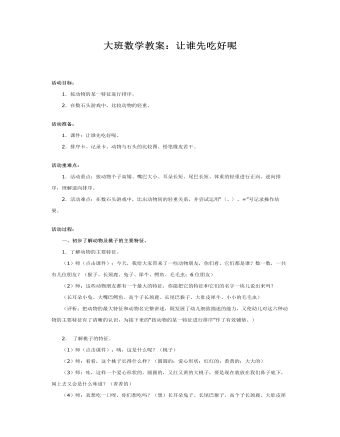
大班数学教案:让谁先吃好呢
活动准备:1.课件:让谁先吃好呢。2.排序卡、记录卡、动物与石头的比较图、铅笔橡皮若干。活动重难点:1.活动重点:按动物个子高矮、嘴巴大小、耳朵长短、尾巴长短、体重的轻重进行正向、逆向排序,理解逆向排序。2.活动难点:在数石头游戏中,比出动物间的轻重关系,并尝试运用“〈、〉、=”号记录操作结果。活动过程: 一、初步了解动物及桃子的主要特征。1.了解动物的主要特征。 (1)师(点击课件):今天,我给大家带来了一些动物朋友,你们看,它们都是谁?数一数,一共有几位朋友?(猴子、长颈鹿、兔子、犀牛、鳄鱼、毛毛虫;6位朋友) (2)师:这些动物朋友都有一个最大的特征,你能把它的特征和它们的名字一块儿说出来吗? (长耳朵小兔、大嘴巴鳄鱼、高个子长颈鹿、长尾巴猴子、大肚皮犀牛、小小的毛毛虫) (评析:把动物的最大特征和动物名完整讲述,既发展了幼儿细致描述的能力,又使幼儿对这六种动物的主要特征有了清晰的认识,为接下来的“按动物的某一特征进行排序”作了有效铺垫。)2.了解桃子的特征。 (1)师(点击课件):咦,这是什么呢?(桃子) (2)师:看看,这个桃子长得什么样?(圆圆的;爱心形状;红红的;黄黄的;大大的) (3)师:哇,这样一个爱心形状的、圆圆的,又红又黄的大桃子,要是现在就放在我们鼻子底下,闻上去又会是什么味道?(香香的) (4)师:真想吃一口呀,你们想吃吗?(想)长耳朵兔子、长尾巴猴子、高个子长颈鹿、大肚皮犀牛、大嘴巴鳄鱼、小小的毛毛虫和我们一样,看到这个桃子,馋得口水都快流出来了,都想先吃到这个大桃子。 (评析:对桃子形状、颜色、大小特征的讲述,以及对桃子气味的猜测,既“勾”起了幼儿品尝桃子的欲望,又“唤”起了他们对动物看到桃子后急切品尝心境的理解,适时、巧妙的引出了本次活动的一条暗藏线索“让谁先吃好呢?”。)二、按动物的某一特征排序。1.按动物高矮、大小、长短排序。 (1)按个子的高矮排序。A.师(点击课件):“按照个子的顺序吃怎么样?”长颈鹿把脖子挺得直直的,先说了一句。那就得先量量看,谁的个子最高了。毛毛虫说:“不能站在高的地方量,量的时候不能把尾巴算上”小兔说:“踮起脚来量也不行。”B.师(点击课件):瞧,他们每人都找了一棵大树开始量了起来。动物们和大树的什么比?(树干)C.师:它们一个个都紧贴着树干,认真的量着。小朋友,你们看出来了吗?谁最高?第二高是谁呢?第三高呢?接下来轮到谁?第五高?最矮的一个是谁呀?D.出示高矮排序图。E.讲述故事:“看见了吧?看见了吧?我的个子最高,所以得我先吃!”长颈鹿把脖子伸得长长的,刚要去咬那个又大又红的桃子。 (2)按嘴巴的大小排序。A.师(点击课件):“不行,这么大的桃子,当然得嘴巴最大的先吃了”鳄鱼张着一张大嘴,站了出来。到底谁的嘴巴最大?B.师(点击课件):“我的嘴巴大!”(犀牛声音)“谁说的!我的嘴巴才是最大的呢!”(鳄鱼声音)C.师:你们说,谁的嘴巴最大?(鳄鱼)E.讲述故事:“听见没,听见没有?我的嘴巴最大,当然是我先吃了!”鳄鱼使足了全身的劲儿,张大嘴巴,马上就要咬到这个又大又红的桃子了…… (3)按耳朵的长短排序。A.师(点击课件):“这么做不行!”蹦蹦跳跳的兔子竖着耳朵跑过来。B.师:欸,兔子会说什么呢?(谁耳朵长谁吃)C.师:那就是说得按什么顺序来吃桃子?(长短顺序)D.师:按什么的长短顺序,谁能完整的说一说?(按耳朵的长短顺序吃)E.师(点击课件):对,应该按照耳朵长短的顺序、谁的耳朵长谁先吃!那就比比,看看到底谁的耳朵最长吧。“看,还是我的耳朵最长吧!”小个子的兔子好不容易够到长颈鹿的脖子,说道。
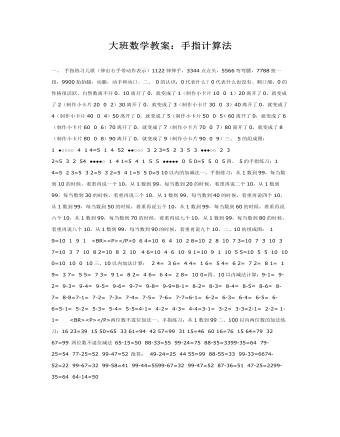
大班数学教案:手指计算法
一、手指练习儿歌(伸出右手带动作表示)1122伸伸手,3344点点头,5566弯弯腰,7788扭一扭,9900抬抬腿,动腿,动手和动口。二、 0的认识:0代表什么?0代表什么也没有。顺口溜:0的性格很活跃,自然数离不开0。10离开了0,就变成了1(制作小卡片10 0 1)20离开了0,就变成了2(制作小卡片20 0 2)30离开了0,就变成了3(制作小卡片30 0 3)40离开了0,就变成了4(制作小卡片40 0 4)50离开了0,就变成了5(制作小卡片50 0 5)60离开了0,就变成了6(制作小卡片60 0 6)70离开了0,就变成了7(制作小卡片70 0 7)80离开了0,就变成了8(制作小卡片80 0 8)90离开了0,就变成了9(制作小卡片90 0 9)三、 5的组成图:1 ●○○○○ 4 14=5 1 4 52 ●●○○○ 3 23=5 2 3 5 3 ●●●○○ 2 32=5 3 2 54 ●●●●○ 1 41=5 4 1 5 5 ●●●●● 0 50=5 5 0 5
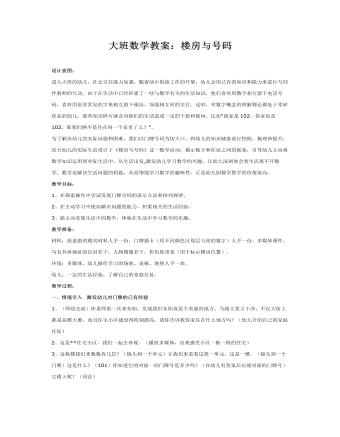
大班数学教案:楼房与号码
为了解决幼儿的实际问题和困难,我们以门牌号码为切入口,将幼儿的知识储备进行挖掘、梳理和提升,结合幼儿的实际生活设计了《楼房与号码》这一数学活动,揭示数字和住址之间的联系,引导幼儿主动将数学知识运用到实际生活中。从生活出发,激发幼儿学习数学的兴趣,让幼儿深刻体会到生活离不开数学,数学是解决生活问题的钥匙,从而增强学习数学的趣味性,正是幼儿园数学教学的价值取向。教学目标:1、在探索操作中尝试发现门牌号码的表示方法和排列规律。2、在主动学习中提高解决问题的能力,积累相关的生活经验。3、能主动发现生活中的数学,体验在生活中学习数学的乐趣。教学准备:材料:纸盒做的楼房材料人手一份,门牌插卡(用不同颜色区别层与间的数字)人手一份,多媒体课件,写有具体地址的信封若干,人物图像若干,彩色胶带卷(用于标示楼房位置)。环境:多媒体、幼儿操作学习的场地、桌椅、地垫人手一块。幼儿:一定的生活经验,了解自己的家庭住址。
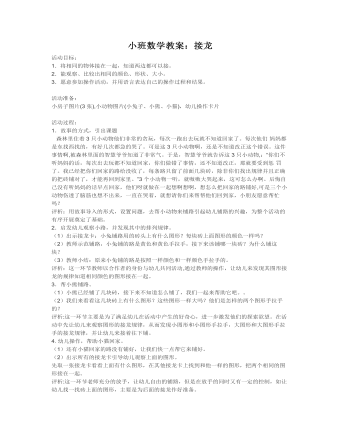
小班数学教案:接龙
2.能观察、比较出相同的颜色、形状、大小。 3.愿意参加操作活动,并用语言表达自己的操作过程和结果。 活动准备: 小房子图片(3张),小动物图片(小兔子、小熊、小猫),幼儿操作卡片 活动过程: 1.故事的方式,引出课题 森林里住着3只小动物他们非常的贪玩,每次一跑出去玩就不知道回家了。每次他们 妈妈都是东找西找的,有好几次都急的哭了。可是这3只小动物啊,还是不知道改正这个错误。这件事情啊,被森林里面的智慧爷爷知道了非常气。于是,智慧爷爷就告诉这3只小动物,:“你们不听妈妈的话,每次出去玩都不知道回家,你们做错了事情,还不知道改正,那就要受到惩 罚了。我已经把你们回家的路给没收了,每条路只留了前面几块砖,除非你们找出规律并且正确的把砖铺对了,才能再回到家里。”3个小动物一听,就嗷嗷大哭起来,这可怎么办啊。后悔自己没有听妈妈的话早点回家,他们呀就做在一起想啊想啊,想怎么把回家的路铺好,可是三个小动物伤透了脑筋也想不出来,一直在哭着,就想请你们来帮帮他们回到家,小朋友愿意帮忙吗? 评析:用故事导入的形式,设置问题,去帮小动物来铺路引起幼儿铺路的兴趣,为整个活动的有序开展奠定了基础。 2.启发幼儿观察小路,并发现其中的排列规律。 (1)出示接龙卡:小兔铺路用的砖头上有什么图形?每块砖上面图形的颜色一样吗? (2)教师示范铺路,小兔铺的路是黄色和黄色手拉手,接下来该铺哪一块砖?为什么铺这块? (3)教师小结:原来小兔铺的路是按照一样颜色和一样颜色手拉手的。 评析:这一环节教师以合作者的身份与幼儿共同活动,通过教师的操作,让幼儿来发现其图形接龙的规律知道相同颜色的图形接在一起。
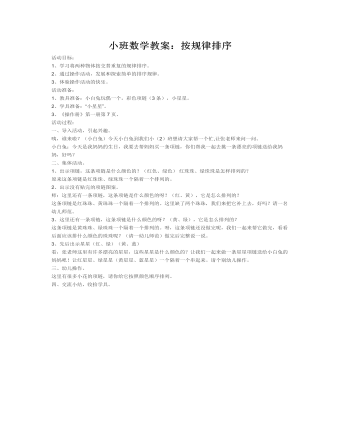
小班数学教案:按规律排序
2、通过操作活动,发展和探索简单的排序规律。 3、体验操作活动的快乐。 活动准备: 1、教具准备:小白兔玩偶一个,彩色项链(3条),小星星。 2、学具准备:“小星星”。 3、《操作册》第一册第7页。 活动过程: 一、导入活动,引起兴趣。 咦,谁来啦?(小白兔)今天小白兔到我们小(2)班想请大家帮一个忙,让张老师来问一问。 小白兔:今天是我妈妈的生日,我要去帮妈妈买一条项链,你们帮我一起去挑一条漂亮的项链送给我妈妈,好吗? 二、集体活动。
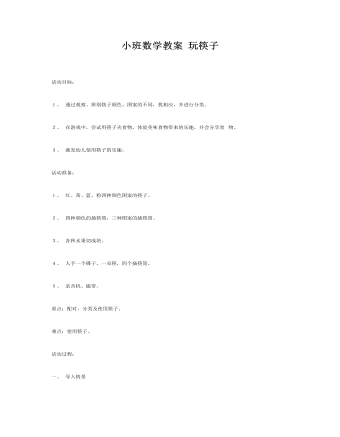
小班数学教案 玩筷子
2、 在游戏中,尝试用筷子夹食物,体验美味食物带来的乐趣,并会分享食 物。3、 激发幼儿使用筷子的乐趣。活动准备:1、 红、黄、蓝、粉四种颜色图案的筷子。2、 四种颜色的插筷筒,三种图案的插筷筒。3、 各种水果切成块。4、 人手一个碟子,一双筷,四个插筷筒。5、 录音机、磁带。重点:配对、分类及使用筷子。难点:使用筷子。活动过程:一、 导入情景1、(出示小熊)小朋友,你们好!今天我想邀请你们去我家做客,你们愿意吗? 2、但是我遇到困难了,你们帮帮我,好吗?二、学习配对1、(出示筷子)你们看,这是什么啊?2、小熊想请我们小朋友给筷子找好朋友,请你们帮他找找好朋友,好吗? 3、请你从后面的桌子上找到一支一模一样的筷子做他的好朋友,好吗? 4、现在请你们从小椅子下面找到筷子,然后去后面找到他的好朋友! 5、幼儿活动――配对。6、 “xxx,请你说说,你为什么找他做好朋友?”(请2-3名幼儿)7、 原来你们是因为他们的颜色和图案一样,才找他们做好朋友的,你们的小眼睛可真亮啊!三、学习分类1、 那你找到筷子的家在哪里吗?2、 <BR><P></P>(出示插筷筒)你们看,这就是筷子的家,它叫插筷筒。它们有什么不同啊?(颜色)这个是什么颜色啊?那这个呢?那就请你把你的筷子送回家,好吗?待会请你们轻轻地把筷子送回家,要有秩序,一个一个放,千万不要把他们送错家了。3、 幼儿活动――分类。4、 请你们看看筷子的家找对了吗?(如找错了,请一名幼儿再找,并说说为什么?)5、 哇,我们小朋友可真棒啊!把红筷子送到了红色的插筷筒里,把黄筷子送到了黄色的插筷筒里,把蓝筷子送到了蓝色的插筷筒里,把粉色的筷子送到了粉色的插筷筒里,真厉害!6、 但是,筷子想找新家了。瞧!这就是他们的新家,他们有什么不同啊?(图案)这个是什么图案?这个呢?对了,一个上面是花花的,一个有蝴蝶,还有一个上面有绿色的图案。7、 现在请你给这些筷子找新家。你喜欢什么样的筷子,你就轻轻地把他从老家拿出来,然后再把他送到新家,好吗?要一个一个有秩序,不然你把筷子弄疼了,他就不理你了。8、 幼儿活动――再次分类。9、 请你们看看筷子的家找对了吗?(如找错了,请一名幼儿再找,并说说为什么?) 10、哇!你们的小眼睛可真亮啊!比孙悟空还厉害啊!
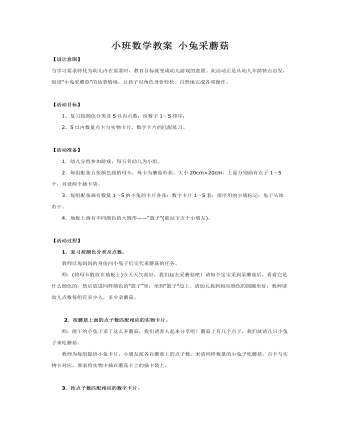
小班数学教案 小兔采蘑菇
【活动目标】1、复习按颜色分类及5以内点数;给数字1~5排序;2、5以内数量点卡与实物卡片、数字卡片的匹配练习。 【活动准备】1.幼儿分组参加游戏,每五名幼儿为小组。2.每组配备五张颜色致的母卡,母卡为蘑菇形状,大小20cm×20cm,上面分别画有点子1~5个,另设两个插卡袋。3.每组配备画有数量1~5的小兔的卡片各张;数字卡片1~5套;排序用的小旗标记;兔子头饰若干。4.地板上画有不同颜色的大圆形——“篮子”(能站下五个小朋友)。
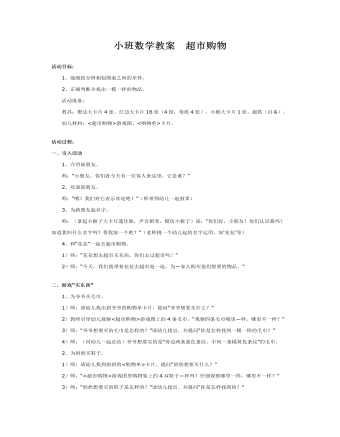
小班数学教案 超市购物
2、正确判断并找出一模一样的物品。 活动准备: 教具:橙边大卡片4张、红边大卡片16张(4组,每组4张)、小猴大卡片1张、磁铁(自备)。 幼儿材料:<超市购物>游戏图、<购物单>卡片。活动过程:一、引入活动 1、介绍新朋友。 师:“小朋友,你们看今天有一位客人来这里,它是谁?” 2、欢迎新朋友。 师:“哦!我们对它表示欢迎吧!”(师带领幼儿一起鼓掌) 3、为新朋友起名字。 师:(拿起小猴子大卡片遮住脸,声音稍变,模仿小猴子)说:“你们好,小朋友!你们认识我吗?知道我叫什么名字吗?帮我取一个吧?”(老师挑一个幼儿起的名字运用,如‘花花’等)
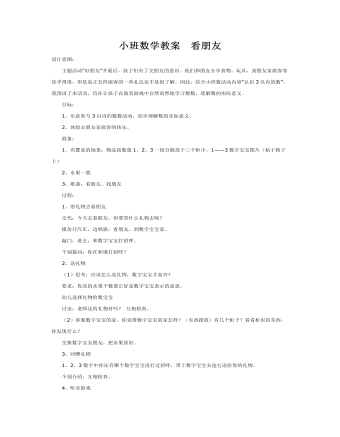
小班数学教案 看朋友
目标: 1、乐意参与3以内的数数活动,初步理解数的实际意义。 2、体验去朋友家做客的快乐。 准备: 1、布置家的场景:物品按数量1、2、3一组分散放于三个柜中。1——3数字宝宝图片(粘于椅子上) 2、水果一篮 3、歌曲:看朋友、找朋友 过程: 1、带礼物去看朋友 交代:今天去看朋友,但要带什么礼物去呢? 模仿开汽车,边唱歌:看朋友,到数字宝宝家。 敲门,进去,和数字宝宝打招呼。 个别提问:你在和谁打招呼?
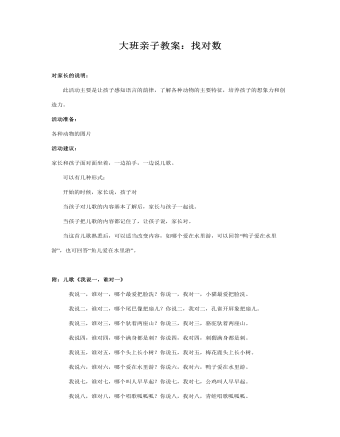
大班亲子教案:找对数
活动准备:各种动物的图片 活动建议:家长和孩子面对面坐着,一边拍手,一边说儿歌。 可以有几种形式: 开始的时候,家长说,孩子对 当孩子对儿歌的内容基本了解后,家长与孩子一起说。 当孩子把儿歌的内容都记住了,让孩子说,家长对。 当这首儿歌熟悉后,可以适当改变内容,如哪个爱在水里游,可以回答“鸭子爱在水里游”,也可回答“鱼儿爱在水里游”。

新人教版高中英语必修3Unit 1 Festivals and Celebrations-Reading for Writing教学设计一
The topic of this part is “Write about your festival experience”.During the Listening and Speaking and Talking, students are just asked to say out their festival experiences such as the Spring Festival, Mid-autumn Day, but this part students will be asked to write down their own festival experiences. During the reading part, it introduces the Naadam Festival in Inner Mongolia Autonomous Region, which can give students a good example to imitate. Students not only learn the festival, but touch and feel the Inner Mongolian’s character, the spirit and cultural atmosphere, which can help students form the cultural awareness and learn to enjoy and value the diversity of Chinese culture.Concretely, the dairy tells the experience that the author spent the Naadam Festival in Inner Mongolia Autonomous Region with his/her friend. The structure is clear. In the opening paragraph, it introduces the topic of the Naadam Festival and the whole feeling. Then it introduces the items of the festival like the ceremony, wrestling and horse racing. Finally, it summarizes this experience. Because this part is a travel journal, we must guide students pay more attention to these details: 1. use the first person. 2. use the past tense to tell the past thing and use the present or future tense to describe the scenery. 3. use the timeline to tell the development. 4. be careful for the author’s psychology, emotion and feeling, etc.1. Read quickly to get main idea; read carefully to get the detailed information about Naadam Festival.2. Learn the structure of the reading article and language.3. Write an article about a festival experience4. Learn to use the psychology, emotions and feeling in the writing.1. Write an article about a festival experience.2. Use the structure of the reading article and language.

新人教版高中英语必修3Unit 4 Space Exploration-Listening&Speaking&Talking教学设计一
Listening and Speaking introduces the topic of “talking about how to become an astronaut”. This period is aimed to inform students some details about the requirements of being an astronaut. Students can be motivated and inspired by the astronauts. Teachers ought to encourage students to learn from them and let them aim high and dream big.Listening and Talking introduces the theme of "talk about life in space". This part also informs students more details about life in space and can inspire students to be curious about this job. 1. Guide students to listen for numbers concerning dates, years and ages etc2. Cultivate students' ability to talk about how to become an astronaut and life in space ; 3. Instruct students to use functional sentences of the dialogue such as “ first of all, I am not sure, so what might be .. I guess.. I wonder…I am curious…)appropriately.1. Guide students to understand the content of listening texts in terms of the whole and key details; 2. Cultivate students' ability to guess the meaning of words in listening; discuss with their peers how to become a qualified astronaut and describe the life in space.Part 1: Listening and SpeakingStep 1: Lead inPredictionThe teacher can ask students to predict what the listening text is about by looking at the pictures.About how to become an astronaut./the requirements of an astronautStep 2: Then, play the radio which is about an interview a. And after finishing listening for the first time, the students need to solve the following tasks.
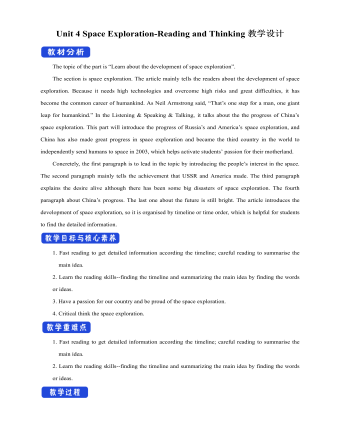
新人教版高中英语必修3Unit 4 Space Exploration-Reading and Thinking教学设计一
Q4: What is the function of the International exploration ?Having astronauts from different countries on boardQ5: What can you learn from Para 4 ?China has made great achievements in exploring spaceQ6: What is the attitude to the space exploration ?SupportiveStep 6 Post reading---RetellPeople have always wanted to learn more about space. Before the mid-20th century, most people felt (1)_________ (travel) into space was an impossible dream. However, (2)____ the help of scientists, peoplesucceeded in realizing their dream (3) _________ (explore) space. On 4 October 1957, the Sputnik 1 satellite (4) ____________(launch) by the USSR. (5) ________________ scientists try to make sure nothing goes wrong, accidents can still happen. These disasters made everyone(6)___________(disappoint), but people still believe in the importance of (7) ________(carry) on space exploration. In 2003, China became the third country to (8)_____________ (independent) send humans into space. Then Shenzhou 6 and 7 completed (9)____ second manned orbit and the first Chinese spacewalk. In spite of the difficulties, scientists hope future (10)__________ (discovery) will not only enable us to understand the universe but also help us survive well into the future.Answers: 1. travelling 2. with 3. to explore 4. was launched 5. Although6. disappointed 7. carrying 8. independently 9. a 10. discoveriesStep 6 Post reading---Critical thinkingQ1: What do you think of the space exploration ? I think it is beneficial to us. Through further study of space, people will make full use of it in the future, such as the space experiments by Wang Yaping in Tian Gong 1.Q2: If you are determined to be an astronaut, what should you prepare at present ?First of all, I should study hard to get a related college degree. Besides, I must keep mental and physical healthy.Step 7. HomeworkTry to summarize the structure of the article by a mind map.

新人教版高中英语必修3Unit 4 Space Exploration-Reading For Writing教学设计一
另一方面,其余的人反对这个计划,因为它可能会导致一些不好的影响。7.I hold the belief that space exploration not only enable us to understand how the universe began but also help us survived well into the future.我坚信探索太空不仅能够使我们了解宇宙的起源而且能够帮助我们更好地走进未来。8.I think we should spend more time and money exploring space so as to provide new and better solutions to people's shortterm and longterm problems.为了给人类的短期和长期问题提供更新和更好的解决方法,我认为我们应该花更多的时间和金钱来探索太空。9.From my point of view,it is wrong of young people to depend on their telephones too much,which may do harm to both their physical and mental health.在我看来,年轻人过度依赖手机是不对的,因为它们可能会对他们的身心健康都有害。最近你班同学就“人类是否应该进行宇宙探索”这个问题进行了激烈的讨论。有人认为,探索宇宙不仅让人类更好地了解宇宙的发展,还可以用来指导农业生产,以及把一些探索太空的高新技术用于现实生活;也有一些人认为探索太空花掉了大量的人力物力;影响了人们的生活水平。请你根据以下情况写一篇报告并发表自己的观点。注意:1.写作内容应包括以上全部要点,可适当发挥,使上下文连贯;
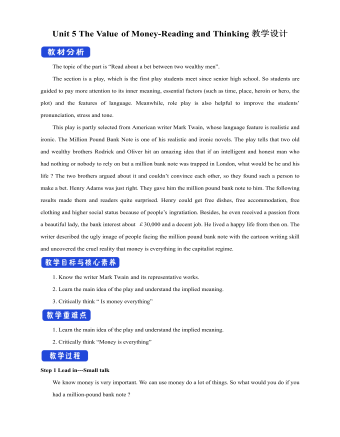
新人教版高中英语必修3Unit 5 The Value of Money-Reading and Thinking教学设计一
Everybody wants to get wealth.In today’s material world,making money or becoming wealthy symbolizes a person’s success and capability. Many people just make every effort, pay any price to attain greater wealth. With money,they can buy nice, large apartments in nice neighborhood. With money they can own luxurious cars. Wealth seems to bring all happiness in life.But is wealth the only road to happiness? Not really. There are many things in the world, which are beyond the means of money, such as friendship, love, health and knowledge. People are so preoccupied with struggling for money that they have no time or would not take the time to form or maintain friendship. What happiness can they feel living as lonely miserable creatures without love or friends in the world even if they accumulate tremendous wealth?In my opinion, people can’t do anything without money, but money is not everything. What money will bring you depends on your personal belief and goal in life. If you are kind enough to help others, especially the poor, money is a good thing to you. With it, you can do much more for the benefit of people and your country, and it will add to your own happiness. If you want money just for your own needs, you’ll never be satisfied or happy. In a word,you should have money spent for more people. Only then can money be the source of your happiness.Step 8 Homework4 students in a group, one acts Roderick, one Oliver, one servant and the fourth one acts Henry Adams, then listen to the tape, pay more attention to the difference between American English and British English in pronunciation, stress, tone.

新人教版高中英语必修3Unit 5 the value of money-Reading For Writing教学设计一
【参考范文】Narrator:(Henry is smiling as he leaves the restaurant. As he is walking down the street, he sees a sign for a place that cuts hair. He decides to get it cut. )H=Henry;B=Barber;R=rude manH:Good afternoon, I'd like to get a cut, if I may. (The barber looks at Henry's hair and continues cutting another man's hair. )Er, I'd really like a haircut. As you can see it's much too long. B:(in a rude manner) Yes, I can see that. Indeed, I can. H:Fine, well I'll have a seat then. (He sits in one of the barber's chairs. The barber turns to look at Henry. )B:It's quite expensive here, you know!Are you sure you can afford it?H:Yes. I think so. (In comes the rude man. )R:Hey you there. I need a haircut quickly. Can you do me straightaway?B:All right, then, get in the chair and I'll see what I can do. R:Thank you. (sits down in one of the barber's chairs)H:Excuse me, but I was here first. Aren't you going to do my hair first?B:This man's in a hurry. H:Well so am I!I insist that you cut my hair first. B:OK, but I'll have to be quick. This gentleman is waiting. H:Thank you. (They both become quiet. After his hair is cut, the barber tells Henry how much he must pay. Henry shows the barber the bank note. )B:Why, Mr . . . (looks shocked)H:Adams. Henry Adams. I'm sorry, I don't have any change. R:You're that Mr Adams! Well,I'm glad I waited or I might never have known it was you. B:Why, Mr Adams, please don't worry!(wearing a big smile) Nothing to worry about!Nothing at all!Please come back any time, even if you only need too little hairs cut!It will be my honour to serve you!
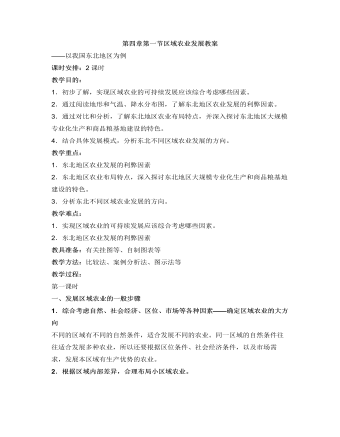
人教版高中地理必修3第四章第一节区域农业发展教案
1.根据下面的材料,归纳珠江三角洲发展基塘生产有利的地理条件。珠江三角洲地势低平,河网密布,降水充沛。北回归线从珠江三角洲的北部穿过。桑树和甘蔗主要分布于热带和亚热带。广州是古代海上丝绸之路的起始地之一。水产品在广东人的食物结构中占有较大的比重。点拨珠江三角洲地区发展基塘农业生产有利条件可以结合材料,归纳为三个方面:地形、气候、市场(当地和海外)具体分析略。2.图4.16所示的基塘生产将哪些产业联系起来?哪些副产品(或废弃物)被充分利用起来?这种联系对农村经济发展有什么作用?点拨基塘生产环节将种植业(桑、蔗等)、养殖业(养蚕、养鱼)、工业(丝厂、糖厂)等几种产业紧密的联系在一起。在此环节中,塘泥、蚕沙(蚕屎)、蚕蛹、缫丝、滤泥、蔗叶等副产品被充分的回收利用。养蚕业、蔗糖加工业同塘鱼养殖业紧密结合,作为一种综合的经营,几者之间相互依存、相互促进、扬长补短,有机地循环联系起来。

